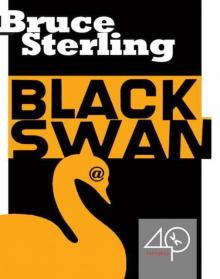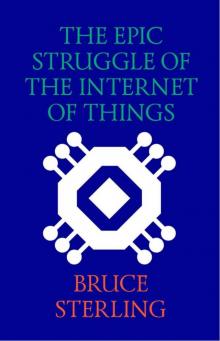- Home
- Bruce Sterling
Essays. Catscan Columns Page 2
Essays. Catscan Columns Read online
Page 2
Then the Literary Gazette calls from Moscow, and asks if you’d like to make a few comments about the work of your new comrades. “Why sure!” you drawl helpfully. “It’s clear as beer-piss that y’all have gotten onto the wrong track entirely! This isn’t literature—this is just a lot of repetitive agitprop crap, dictated by your stupid oppressive publishers! If Tolstoy was alive today, he’d kick your numb Marxist butts! All this lame bullshit about commie heroes storming Berlin and workers breaking production records—those are stupid power-fantasies that wouldn’t fool a ten-year-old! You wanna know the true modern potential of Russian novels? Read some of my stuff, if you can do it without your lips moving! Then call me back.”
And sure enough, they do call you back. But gosh—some of the hardliners in the Writers’ Union have gone and drummed you out of the regiment. Called you all kinds of names … said you’re stuck-up, a tool of capitalism, a no-talent running-dog egghead. After that, you go right on writing, even criticism, sometimes. Of course, after that you start to get MEAN.
This really happened.
Except that it wasn’t Tolstoy and Dostoevsky. It was H.G. Wells and Olaf Stapledon. It wasn’t Russian novels, it was science fiction, and the Writers’ Union was really the SFWA. And Alabama was Poland.
And you were Stanislaw Lem.
Lem was surgically excised from the bosom of American SF back in 1976. Since then plenty of other writers have quit SFWA, but those flung out for the crime of being a commie rat-bastard have remained remarkably few. Lem, of course, has continued to garner widespread acclaim, much of it from hifalutin’ mainstream critics who would not be caught dead in a bookstore’s skiffy section. Recently a collection of Lem’s critical essays, Macroworlds, has appeared in paperback. For those of us not privy to the squabble these essays caused in the ’70s, it makes some eye-opening reading.
Lem compares himself to Crusoe, stating (accurately) that he had to erect his entire structure of “science fiction” essentially from scratch. He did have the ancient shipwrecked hulls of Wells and Stapledon at hand, but he raided them for tools years ago. (We owe the collected essays to the beachcombing of his Man Friday, Austrian critic Franz Rottensteiner.)
These essays are the work of a lonely man. We can judge the fervor of Lem’s attempt to reach out by a piece like “On the Structural Analysis of Science Fiction:” a Pole, writing in German, to an Austrian, about French semantic theory. The mind reels. After this superhuman effort to communicate, you’d think the folks would cut Lem some slack—from pure human pity, if nothing else.
But Lem’s ideology—both political and literary- -is simply too threatening. The stuff Lem calls science fiction looks a bit like American SF—about the way a dolphin looks like a mosasaur. A certain amount of competitive gnawing and thrashing was inevitable. The water roiled ten years ago, and the judgement of evolution is still out. The smart money might be on Lem. The smarter money yet, on some judicious hybridization. In any case we would do well to try to understand him.
Lem shows little interest in “fiction” per se. He’s interested in science: the structure of the world. A brief autobiographical piece, “Reflections on My Life,” makes it clear that Lem has been this way from the beginning. The sparkplug of his literary career was not fiction, but his father’s medical texts: to little Stanislaw, a magic world of skeletons and severed brains and colorful pickled guts. Lem’s earliest “writings,” in high school, were not “stories,” but an elaborate series of imaginary forged documents: “certificates, passports, diplomas … coded proofs and cryptograms …”
For Lem, science fiction is a documented form of thought-experiment: a spearhead of cognition.
All else is secondary, and it is this singleness of aim that gives his work its driving power. This is truly “a literature of ideas,” dismissing the heart as trivial, but piercing the skull like an ice-pick.
Given his predilections, Lem would probably never have written “people stories.” But his rationale for avoiding this is astounding. The mass slaughters during the Nazi occupation of Poland, Lem says, drove him to the literary depiction of humanity as a species. “Those days have pulverized and exploded all narrative conventions that had previously been used in literature. The unfathomable futility of human life under the sway of mass murder cannot be conveyed by literary techniques in which individuals or small groups of persons form the core of the narrative.”
A horrifying statement, and one that people in happier countries would do well to ponder. The implications of this literary conviction are, of course, extreme. Lem’s work is marked by unflinching extremities. He fights through ideas with all the convulsive drive of a drowning man fighting for air. Story structure, plot, human values, characterization, dramatic tension, all are ruthlessly trudgeon-kicked aside.
In criticism, however, Lem has his breath, and can examine the trampled flotsam with a cynical eye. American SF, he says, is hopelessly compromised, because its narrative structure is trash: detective stories, pulp thrillers, fairy-tales, bastardized myths. Such outworn and kitschy devices are totally unsuited to the majestic scale of science fiction’s natural thematics, and reduce it to the cheap tricks of a vaudeville conjurer.
Lem holds this in contempt, for he is not a man to find entertainment in sideshow magic. Stanislaw Lem is not a good-time guy. Oddly, for a science fiction writer, he seems to have very little interest in the intrinsically weird. He shows no natural appetite for the arcane, the offbeat, the outre.. He is colorblind to fantasy. This leads him to dismiss much of the work of Borges, for example. Lem claims that “Borges’ best stories are constructed as tightly as mathematical proofs.” This is a tautology of taste, for, to Lem, mathematical proofs are the conditions to which the “best” stories must necessarily aspire.
In a footnote to the Borges essay Lem makes the odd claim that “As soon as nobody assents to it, a philosophy becomes automatically fantastic literature.” Lem’s literature is philosophy; to veer from the path of reason for the sake of mere sensation is fraudulent.
American SF, therefore, is a tissue of frauds, and its practicioners fools at best, but mostly snake-oil salesmen. Lem’s stern puritanism, however, leaves him at sea when it comes to the work of Philip K. Dick: “A Visionary Among the Charlatans.” Lem’s mind was clearly blown by reading Dick, and he struggles to find some underlying weltanschauung that would reduce Dick’s ontological raving to a coherent floor-plan. It’s a doomed effort, full of condescension and confusion, like a ballet-master analyzing James Brown.
Fiction is written to charm, to entertain, to enlighten, to convey cultural values, to analyze life and manners and morals and the nature of the human heart. The stuff Stanislaw Lem writes, however, is created to burn mental holes with pitiless coherent light. How can one do this and still produce a product resembling “literature?” Lem tried novels. Novels, alas, look odd without genuine characters in them. Then he hit on it: a stroke of genius.
The collections A Perfect Vacuum and Imaginary Magnitudes are Lem’s masterworks. The first contains book reviews, the second, introductions to various learned tomes. The “books” discussed or reviewed do not actually exist, and have archly humorous titles, like “Necrobes” by “Cezary Strzybisz.” But here Lem has found literary structures—not “stories”—but assemblages of prose, familiar and comfortable to the reader.
Of course, it takes a certain aridity of taste to read a book composed of “introductions,” traditionally a kind of flaky appetizer before the main course. But it’s worth it for the author’s sense of freedom, his manifest delight in finally ridding himself of that thorny fictive thicket that stands between him and his Grail. These are charming pieces, witty, ingenious, highly thought-provoking, utterly devoid of human interest. People will be reading these for decades to come. Not because they work as fiction, but because their form follows function with the sinister elegance of an automatic rifle.
Here Lem has finessed an irrevocable choice. It is a choice every sci
ence fiction writer faces. Is the writer to write Real Novels which “only happen to be” science fiction—or create knobby and irreducible SF artifacts which are not true “stories,” but visionary texts? The argument in favor of the first course is that Real Readers, i.e. mainstream ones, refuse to notice the nakedly science-fictional. How Lem must chuckle as he collects his lavish blurbs from Time and Newsweek (not to mention an income ranking as one of poor wretched Poland’s best sources of foreign exchange) . By disguising his work as the haute-lit exudations of a critic, he has out-conjured the Yankee conjurers, had his cake and eaten it publicly, in the hallowed pages of the NY Review of Books.
It’s a good trick, hard to pull off, requiring ideas that burn so brilliantly that their glare is overwhelming. That ability alone is worthy of a certain writhing envy from the local Writers’ Union. But it’s still a trick, and the central question is still unresolved. What is “science fiction,” anyway? And what’s it there for?
CATSCAN 3 “Updike’s Version”
John Updike has got to be the epitome of everything that SF readers love to hate. Those slim, clever, etiolated mainstream novels about well-to-do New Yorker subscribers, who sip white wine and contemplate adultery … Novels stuffed like Christmas geese with hifalutin’ literary values … Mention Updike at a SFWA gig, and you get yawns, shudders, shakings of the head . . His work affects science fiction writers like cayenne pepper affects a pack of bloodhounds.
Why? Because John Updike has everything SF writers don’t. He is, in some very real sense, everything SF writers aren’t.
Certain qualities exist, that novelists are popularly supposed to possess. Gifts, abilities, that win An Author respect, that cause folks to back off and gape just a bit if they find one in a grocery line. Qualities like: insight into modern culture. A broad sympathy for the manifold quirks of human nature. A sharp eye for the defining detail. A quick ear for language. A mastery of prose.
John Updike possesses these things. He is erudite. He has, for instance, actually read Isak Dinesen, Wallace Stevens, Ciline, Jean Rhys, Gunter Grass, Nabokov and Bellow. Not only has he read these obscure and intimidating people, but he has publicly discussed the experience with every sign of genuine enjoyment.
Updike is also enormously clever, clever to a point that approaches genius through the sheer irrepressible business of its dexterity. Updike’s paragraphs are so brittle, so neatly nested in their comma’ed clauses, that they seem to burst under the impact of the reader’s gaze, like hyper-flaky croissants.
Updike sees how things look, notices how people dress, hears how people talk. His eye for the telling detail can make even golf and birdwatching, the ultimate yawnable whitebread Anglo pastimes, more or less interesting. (Okay—not very interesting, granted. But interesting for the sheer grace of Updike’s narrative technique. Like watching Fred Astaire take out the garbage.)
It would be enlightening to compare John Updike to some paragon of science fiction writing. Unfortunately no such paladin offers himself, so we’ll have to make do with a composite.
What qualities make a great science fiction writer? Let’s look at it objectively, putting aside all that comfortable bullshit about the virtues authors are supposed to have. Let’s look at the science fiction writer as he is.
Modern culture, for instance. Our SF paladin is not even sure it exists, except as a vaguely oppressive force he’s evaded since childhood. He lives in his own one-man splinter culture, and has ever since that crucial time in childhood—when he was sick in bed for two years, or was held captive in the Japanese prison camp, or lived in the Comoros Islands with monstrous parents who were nuts on anthropology or astronomy or Trotsky or religion.
He’s pretty much okay now, though, our science fiction author. He can feed himself and sign checks, and he makes occasional supply trips into the cultural anchorage of SF fandom, where he refreshes his soul by looking at people far worse off than he is. But he dresses funny, and mumbles to himself in the grocery line.
While standing there, he doesn’t listen to the other folks and make surreptitious authorly notes about dialogue. Far from it: he’s too full of unholy fire to pay much attention to mere human beings. And anyway, his characters generally talk about stuff like neutrinos or Taoism.
His eyes are glazed, cut off at the optic nerve while he watches brain-movies. Too many nights in too many cheap con hotels have blunted his sense of aesthetics; his characters live in geodomes or efficiencies or yurts. They wear one-piece jumpsuits because jumpsuits make people one monotonous color from throat to foot, which allows our attention to return to the neutrinos—of which, incidentally, ninety percent of the universe consists, so that the entire visible world of matter is a mere froth, if we only knew.
But he’s learned his craft, our science fiction paladin. The real nutcases don’t have enough mental horsepower to go where he’s gone. He works hard and he thinks hard and he knows what he’s doing. He’s read Kuttner and Kornbluth and Blish and Knight, and he knows how to Develop an Idea entertainingly and rigorously, and how to keep pages turning meanwhile, and by Christ those are no easy things. So there, Mr. John Updike with your highflown talk of aht and beautieh. That may be okay for you Ivy League pinky-lifters with your sissy bemoaning about the Crisis of Culture … As if there was going to be a culture after the millennial advent of (Biotech) (Cybernetics) (Space Travel) (Robots) (Atomic Energy) (General Semantics) (Dean Drive) (Dianetics) …
So—there’s the difference. It exists, for better or worse. None of this is lost on John Updike. He knows about science fiction, not a hell of a lot, but probably vastly more than most science fiction writers know about John Updike. He recognizes that it requires specialized expertise to write good SF, and that there are vast rustling crowds of us on the other side of the cultural spacewarp, writing for Ace Books and Amazing Stories. Updike reads Vonnegut and Le Guin and Calvino and Lem and Wells and Borges, and would probably read anybody else whose prose didn’t cause him physical pain. And from this reading, he knows that the worldview is different in SFville … that writers think literature, and that SF writers think SF.
And he knows, too, that it’s not T.S. Eliot’s world any more, if indeed it ever was T.S. Eliot’s world. He knows we live in a world that loves to think SF, and has thought SF ever since Hiroshima, which was the ne plus ultra of Millennial Technological Advents, which really and truly did change the world forever.
So Updike has rolled up his pinstriped sleeves and bent his formidable intelligence in our direction, and lo we have a science fiction novel, Roger’s Version by John Updike.
Of course it’s not called a science fiction novel. Updike has seen Le Guin and Lem and Vonnegut crawl through the spacewarp into his world. He’s seen them wriggle out, somehow, barely, gasping and stinking of rocket fuel. Updike has no reason to place himself in a position they went to great pains to escape. But Roger’s Version does feature a computer on its cover, if not a rocketship or a babe in a bubble helmet, and by heaven it is a science fiction novel—and a very good one.
Roger’s Version is Updike’s version of what SF should be on about. It deals with SF’s native conceptual underpinnings: the impact of technology on society. The book is about technolatry, about millennial visionary thinking. This is SF-think as examined by a classic devotee of lit-think.
It’s all there, quite upfront and nakedly science fictional. It puzzles mainstream commentators. “It’s as though Updike had challenged himself to convert into the flow of his novel the most resistant stuff he could think of,” marvels the Christian Science Monitor, alarmed to find a Real Novel that actually deals straightforwardly with real ideas. “The aggressiveness of Updike’s imagination is often a marvel,” says People, a mag whose utter lack of imagination is probably its premier selling point.
And look at this list of author’s credits: Fred Hoyle, Martin Gardner, Gerald Feinberg, Robert Jastrow. Don’t tell me Updike’s taken the science seriously. But he has—he’s not the man to den
y the devil his due, especially after writing Witches of Eastwick, which would have been called a fantasy novel if it had been written badly by a nobody.
But enough of this highflown abstraction—let’s get to grips with the book. There’s these two guys, see. There’s Roger Lambert, a middle-aged professor of theology, a white-wine-sipping adultery-contemplating intellectual New Englander who probably isn’t eighty light-years removed from John Updike. Roger’s a nasty piece of business, mostly, lecherous, dishonest and petty-minded, and obsessed with a kind of free-floating Hawthornian Protestant guilt that has been passed down for twenty generations up Boston way and hasn’t gotten a bit more specific in the meantime.
And then there’s Roger Lambert’s antagonist, Dale Kohler. Dale’s a young computer hacker with pimples and an obnoxious cocksure attitude. If Dale were just a little more hip about it, he’d be a cyberpunk, but for thematic reasons Updike chose to make Dale a born-again Christian. We never really believe this, though, because Dale almost never talks Jesus. He talks AND-OR circuits, and megabytes, and Mandelbrot sets, with all the techspeak fluency Updike can manage, which is considerable. Dale talks God on a microchip, technological transcendence, and he was last seen in Greg Bear’s Blood Music where his name was different but his motive and character were identical. Dale is a type. Not just a science fictional type, but the type that creates science fiction, who talks God for the same reason Philip K. Dick talked God. Because it comes with the territory.
Oh yeah, and then we’ve got some women. They don’t amount to much. They’re not people, exactly. They’re temptresses and symbols.
There’s Roger Lambert’s wife, Esther, for instance. Esther ends up teaching Dale Kohler the nature of sin, which utterly destroys Dale’s annoying moral certitude, and high time, too. Esther does this by the simple expedient of adulterously fucking Dale’s brains out, repeatedly and in meticulously related detail, until Dale collapses from sheer weight of original sin.

 Mirrorshades: The Cyberpunk Anthology
Mirrorshades: The Cyberpunk Anthology The Wonderful Power of Storytelling
The Wonderful Power of Storytelling Love Is Strange (A Paranormal Romance)
Love Is Strange (A Paranormal Romance) Globalhead
Globalhead Essays. FSF Columns
Essays. FSF Columns The Hacker Crackdown
The Hacker Crackdown Bicycle Repairman
Bicycle Repairman Black Swan
Black Swan Crystal Express
Crystal Express Islands in the Net
Islands in the Net Pirate Utopia
Pirate Utopia GURPS' LABOUR LOST
GURPS' LABOUR LOST The Dead Media Notebook
The Dead Media Notebook Unstable Networks
Unstable Networks The Manifesto of January 3, 2000
The Manifesto of January 3, 2000 Heavy Weather
Heavy Weather Involution Ocean
Involution Ocean The Epic Struggle of the Internet of Things
The Epic Struggle of the Internet of Things A Good Old-Fashioned Future
A Good Old-Fashioned Future The Littlest Jackal
The Littlest Jackal Zeitgeist
Zeitgeist Totem Poles
Totem Poles Ascendancies
Ascendancies CyberView 1991
CyberView 1991 War Is Virtual Hell
War Is Virtual Hell Taklamakan
Taklamakan Holy Fire
Holy Fire Cyberpunk in the Nineties
Cyberpunk in the Nineties Schismatrix Plus
Schismatrix Plus The Artificial Kid
The Artificial Kid Essays. Catscan Columns
Essays. Catscan Columns Maneki Neko
Maneki Neko Distraction
Distraction In Paradise
In Paradise Red Star, Winter Orbit
Red Star, Winter Orbit Luciferase
Luciferase